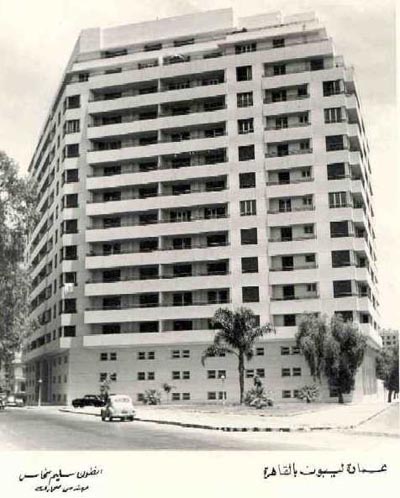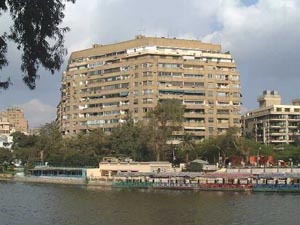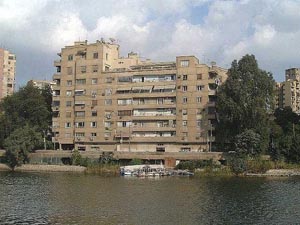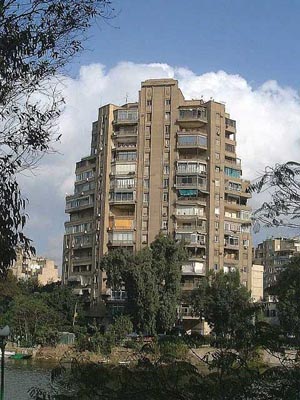
Lebon Building almost completed. Picture courtesy of Selim Nahas
|
|
|
|
|
Cheers to our "talented" literature prize awardee. Your pain his gain !!!
|
|
|
EGY.COM - ZAMALEK
|
|
|
|
|
Cairo Times, 23 December 1999 |

Lebon Building almost completed. Picture courtesy of Selim Nahas
The entrance of the Lebon building on Gabalaya Street has been restored. Suddenly, a page in Zamalek's old architectural book is worth reading for the first time in decades.
Lebon along with the Union and Ali-Labib Gabr buildings "are the three grand ladies of Zamalek," says Mona Foda, pioneer real estate agent specializing in luxury apartments overlooking the Nile.
No doubt about it, grand in scale these three buildings have always been. Yet, until very recently, visitors from abroad often wondered what had happened to the rich architectural history of this country. Good question.
Some may tell you that apartment and office buildings east and west of the Nile built between 1960 and 1990 should be written off as instant council houses. They are, to say the least, void of any architectural appeal. Worse still are the accumulated horrors of Nasr City and those of Mohandessine, two ugly urban sprawls conceived in the 1960s. Ironically, the latter is known as the nation's "engineers district". You could have fooled anyone!
Two decades of socialism and a host of rent control laws have dulled the mind. Meanwhile, the Grand Old Ladies of Zamalek and their cousins across Cairo were painted over with grime. One by one, their regal foyers saw their embellishments and accoutrements replaced by neon lights and cracked mirrors. And while their respective flower-boxes, marble fountains and oak letterboxes receded into the dark, beneficiaries of these buildings retreated into xenophobia. It is as though their civil responsibilities ended at their front door. The rest was up to Uncle Socialism, their new, useless landlord.
Ok, so Lebon was built in the early 1950s at a time when Cairo was booming with money, taste and a sense of proportion. Fifty years later the building is being restored in an era rife with fraudulent opulence. But the question remains; Are any of its incumbent residents grand enough for the setting this building represents.

When businessman Wafik Shamaa asked his wealthy neighbors to chip in for the upgrading and restoration of the building's utilities and public areas, less than 50% responded. "I'm nevertheless pleased with the result" he says. "Had I made that same request 15 years ago the response would have been less than 10%."
A disapointing outcome especially when one learns Lebon is home to the country's leading politicians, legislators, senior diplomats as well as screen Godess Faten Hamama and former teen idol Sherihan.
Shamaa accedes we are beginning to realize socialism is dead and that a businesslike approach to maintenance and restoration could extend and as well as enrich the city's remarkable architectural legacy. "More importantly we all stand to gain financially from this turnaround." Figures speak for themselves-- a large apartment in Lebon now sells in excess of LE 3 million pounds.
Architects Ali Labib Gabr (original owner of the building by the same name on Ibn Zinki Street); Garo Balyan and Max Edrei (designers of the Union Vie Building on Gabalaya Street); and Antoine Selim Nahas (author of Lebon) had never tasted socialism. They studied architecture in the West at a time when Frank Lloyd Wright made headlines in America and Le Corbusier and Hausmann were still evoked in Paris. Committed to bringing back part of what they had seen, they were bent on making a difference in Cairo.
A difference that would not only enrich Cairo's skyline, but also spark Egyptian architects into the realm of the attractive.

A difference that would be valuable in bad times just as it had when the going was good. Hence the reason why during socialism's heyday, Egypt's rising aparatchiks unabashedly tailored decrees enabling them to lay their hands on apartments hastily vacated by the captains and kings of Egypt's defunct industry.
When the Compagnie Centrale d'Eclairage et de Chauffage par le Gaz (LEBON) was nationalized in 1961, its Zamalek building, like many others in the same league, passed on to a state-owned insurance company where favors were hawked to the regime's favorite cronies.
How curious that none of Nasser's henchmen and would-be praise-writers wanted to live in his un-elegant Nasr City. The age of injustice had begun where bad money ousted good money, crass replaced brass, haste overtook taste, and maintenance was synonymous to decadence.
The result was devastating all around. Save for the aparatchik, almost everyone suffers. From people plunging into dirty elevator shafts, to absentee landlord whose apartments were taken over by party informers. And while the original owner/lessor of an apartment received a measly LE 25 pounds rent, the sub-lessor raked in US$ 2,500. But does he plough back any of his gains into the building's general upkeep? Certainly not! Let Uncle Socialism fix it!
Today there are signs this complacency is changing. Zamalek's grand old ladies are having minor facelifts. Their marble floorings have been polished and their letterboxes look like letterboxes once again.
The restitution of Lebon's palatial entrance is a welcome sign that after years of neglect and abandon, Cairo's albeit privileged inhabitants are appreciating, and restoring to public view some of the city's landmark buildings. And in a departure that some critics will deride as overly pro-capitalistic, these efforts are mostly a result of privatization and, yes, a belated re-awakening of basic civic responsibilities.

Union Building by Max Edrei and Garo Balyan
The name Lebon comes from Charles Lebon the man who established a gas producing plant in Alexandria in the 1860s and was the exclusive concessionnaire providing public gas lighting in the city of Alexandria. On 15 February 1865 he was awarded a 75 year contract to provide the same service in the city of Cairo.
|
Reader Comments |
Subject: Lebon Building |
|
|
|
|